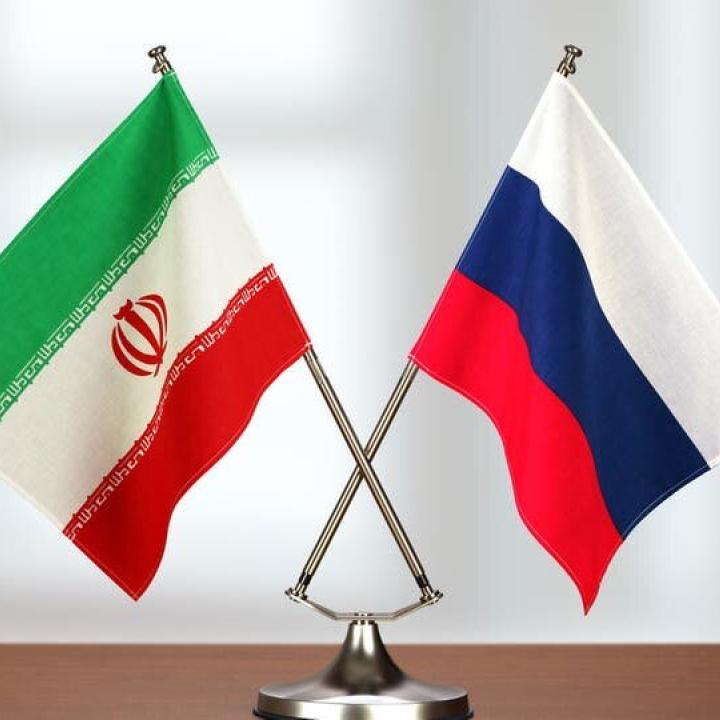
- Policy Analysis
- PolicyWatch 3693
After Ukraine: Russia’s Potential Military and Nuclear Compensation to Iran

Despite the obstacles to expanded cooperation, Russian aid could help Tehran promote repression at home and instability abroad, so the United States and its allies should seek to deter such collaboration wherever possible.
The Iran-Russia axis that has emerged in the wake of the Ukraine invasion has raised questions about how Moscow might compensate Tehran for its support. In return for the use of Iranian combat drones in Ukraine, Western officials indicate that Moscow may provide the regime with fighter jets, air defense systems, and helicopters, as well as naval assistance in the form of warships and help with producing new vessels. An Iranian parliamentarian recently noted the “pending” delivery of Su-35 fighters, air defense systems, and helicopters.
Such reports hint at a broader high-tech and defense partnership rather than a simple transactional arrangement. As U.S. National Security Council official John Kirby noted last month, “Russia is offering Iran an unprecedented level of military and technical support that is transforming their relationship.” For years now, the international arms embargo and harsh economic sanctions against Iran have greatly hampered its capacity to modernize its armed forces. Yet potential Russian transfers could meet some of the regime’s most pressing needs and make important contributions to its military capabilities.
Tech Transfers, Not Massive Weapons Acquisitions
Iran’s asymmetric and hybrid force structure—which emphasizes missiles, drones, proxy militias, and sea denial capabilities—has served it well, so it is unlikely to seek a major military makeover. Moreover, Tehran lacks the funds to purchase large numbers of costly conventional arms, and it is unclear how many of them Moscow would be willing or able to provide at a time when its own military is taking heavy losses in Ukraine.
Yet even limited arms and technology transfers may enable Iran to fill gaps in its force structure, selectively modernize, and bolster its domestic arms production capabilities. Smaller weapons transfers would still provide useful insights for reverse engineering, while obtaining high-end technology would bolster the regime’s long-term efforts to modernize its forces and achieve greater military self-sufficiency.
Iran has already made significant progress in upgrading and thickening its ground-based air defenses using an array of domestically produced systems and Russian S-300 missile batteries. Acquiring Russian S-400s would further strengthen its long-range/high-altitude air defense capabilities and provide it with some missile defense capability. If delivered in sufficient numbers, advanced interceptors and air defense systems could complicate an Israeli preventive strike against Iran’s nuclear facilities and constrain Israeli air operations over Syria if deployed there—though they would not significantly affect the outcome of a broader American air campaign against Iran.
Moreover, the potential delivery of twenty-four Su-35s would improve Iran’s flexibility and responsiveness to emerging aerial threats. These multirole fighters can also be armed with long-range air-to-ground weapons that would enable standoff strikes against neighboring states.
In addition to potentially buying helicopters from Moscow, Iran is interested in receiving help from Russian companies to start a domestic production line or develop helicopter types jointly. Possible candidates for acquisition or joint production are the Mil Mi-38, Mi-28N, and Kamov Ka-32/-226/-60/-52 transport/utility and attack helicopters. Yet any such cooperation would depend on Russia resolving its own issues with helicopter production, such as establishing an alternative engine production line now that its previous Ukraine-based line is no longer available.
On the naval front, Iran has encountered problems in meeting its blue-water aspirations and might be interested in obtaining Russian warships and know-how. It has produced only a handful of corvettes and frigates, based largely on outdated designs, and resorted to converting tankers to serve as expeditionary sea bases or drone carriers. Russia’s post-Cold War emphasis on smaller vessels that pack a big punch would fit well with Iran’s emphasis on small, missile-armed surface combatants, but Moscow has had trouble producing them in large numbers, and recent sanctions will compound this problem.
Submarines are another possible area of major cooperation. Iran has been developing several indigenous designs, but it could benefit immensely from Russian technological input, joint production, or the purchase of several completed midsize diesel-electric submarines.
Elsewhere, the acquisition of a constellation of Russian imaging satellites would enable Iran to employ its drones and missiles more effectively and improve its early-warning and targeting capabilities. Tehran could also benefit from liquid-fuel rocket motor technology for its ballistic missiles and space-launch vehicles. Although it has made significant progress on solid-fuel rockets, its liquid-fuel designs are lagging behind.
Potential Nuclear Assistance
The form of assistance Russia is most likely to provide in the nuclear space is diplomatic. In the past few months, Moscow has heightened its support for Iran at the International Atomic Energy Agency’s Board of Governors, and it will likely continue shielding Tehran from referral to the UN Security Council regarding the regime’s noncompliance with nuclear safeguards obligations.
Conceivably, Russia could also contribute to a potential future Iranian nuclear weapons effort by providing technology and know-how, whether covertly or openly. For instance, Russian scientists could help Iran advance its R&D on delivery systems, warhead development, and miniaturization, or collaborate on dual-use research relevant to weaponization. Yet there are many reasons to be skeptical of these scenarios. Besides running counter to Russia’s official stance against Iranian nuclear weapons development, such assistance would antagonize Moscow’s Gulf partners.
That said, the Russian government has not viewed Iran’s potential development of nuclear weapons with the same degree of alarm as the West. Moreover, the Ukraine war may have reshuffled Moscow’s strategic calculus to the point where it views such assistance as a means of undermining U.S. interests in the region. Even if it eschews official assistance, deepened contacts between the two countries and the continued deterioration of Russia’s economy might spur its engineers and scientists to conduct unauthorized work that benefits Iran’s nuclear program, as occurred in the past. That said, this degree of collaboration might be a step too far for Iran given its longstanding distrust of Russia, the risk of exposing its most sensitive projects and secrets, and its continued insistence that it does not have a nuclear weapons program.
On the civilian side, Iran could seek more help in developing its nuclear power industry. Russia built the first Bushehr reactor and is constructing two additional ones. The new reactors are at least two years behind schedule, but Moscow could commit to accelerating construction or offer better financial terms. It could also help with reactor fuel fabrication. If Iran were able to make its own fuel for Bushehr and similar future reactors, it would have a better civilian justification for maintaining an industrial uranium enrichment capacity. Yet Russia currently provides fuel for Bushehr and may not want to put itself out of business, especially as its nuclear industry faces pressure in Europe.
Other Types of Compensation
Iran might also be interested in expanding cooperation with Russia in the cyber domain, trade and investment, and technologies that bolster regime security. Tehran has placed great emphasis on augmenting its cyber capabilities but still lags far behind Moscow. After watching Russia’s cyber-interference in the 2016 U.S. presidential election, Iran joined Moscow in attempting to influence the 2020 election campaign (even as they sought different outcomes). In January 2021, the two governments signed an agreement on cybersecurity cooperation.
On trade, the two governments are accelerating efforts to build the International North-South Transport Corridor (INSTC), though it faces many implementation challenges. They have also pledged to expand bilateral trade and investment as well as cooperation in the oil and gas sector, both of which face substantial hurdles.
Iran might also look to Russia for help with internal security, especially in light of the ongoing anti-regime protests sweeping the country. Potential products it may hope to acquire include vehicles and nonlethal systems for crowd control as well as facial recognition and tracking technologies.
Recommendations and Opportunities
To deter the aforementioned transfers, the United States should signal Iran and Russia that they risk compromising any systems or capabilities they provide to one another, enabling Washington and its allies to develop countermeasures against them and supply these measures to partners in the Middle East and Europe. At the same time, Western governments should improve their coordination on export controls relating to components that could be used in drones. Washington should also make clear to Moscow and Tehran that it will continue to publicize details regarding the most sensitive aspects of their relationship.
In addition, the United States should lean on Saudi Arabia and the United Arab Emirates to pressure Russia on limiting its transfers to Iran given the risk they would pose to regional security. Washington should also share intelligence on Iran’s requests with Riyadh, Abu Dhabi, and Jerusalem, which would give them further incentive to discourage Moscow from following through. Finally, the West should use these potential transfers as examples when messaging Saudi and Emirati leaders and their publics about the risks of their hedging strategies in the Ukraine war.







